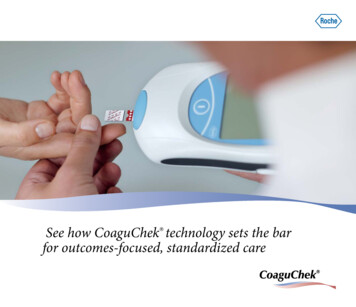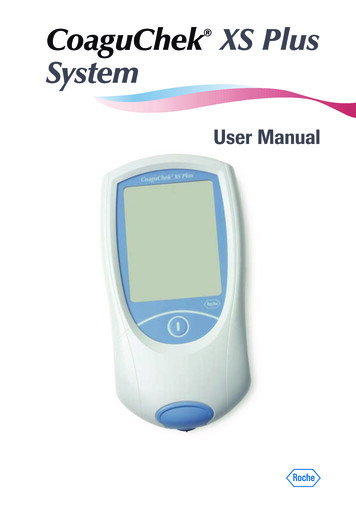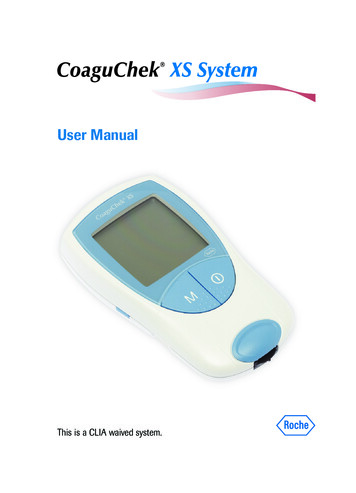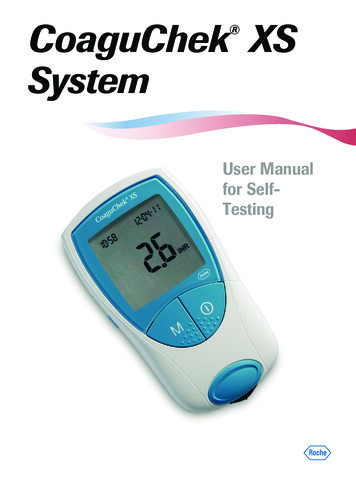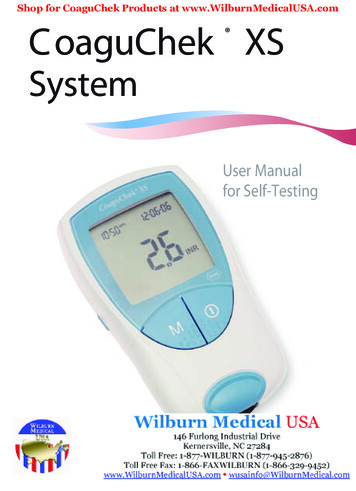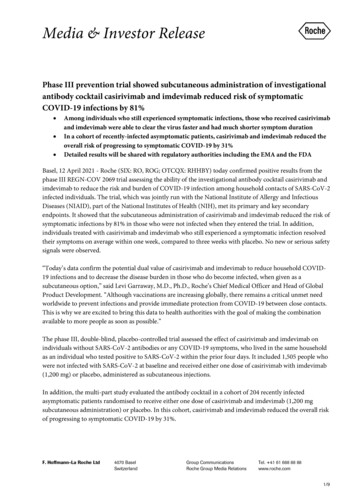
Transcription
1.Roche CoaguChek XS METHOD AND SAMPLECOLLECTIONPURPOSE AND SCOPEThe purpose of this document is to describe the procedure for performing an INRtest using the Roche CoaguChek XS analyser. The CoaguChek XS meter can beused by healthcare professionals or patients for measuring INR. This method is tobe used for the determination of prothrombin time (PT) and INR in capillary andvenous whole blood. This test is used for monitoring oral anticoagulant therapy andlong-term therapy with Coumarin derivatives.2.HAZARDSPatient SamplesAll patient samples should be treated as potentially infectious and handledappropriately. Standard precautions should be employed. Personal ProtectiveEquipment should be worn when processing samples, quality control testing andmaintenance procedures.3.CLINICAL SIGNIFICANCEOral anticoagulation therapy is the established treatment for patients suffering froma range of conditions in which it is necessary to inhibit the formation of blood clotswithin the circulation.The major indications for anticoagulation include: Prevention of thrombosis in patients with prosthetic heart valves/stents Treatment and secondary prevention of venous thromboembolism Primary prevention of venous thromboembolism in high risk patients Primary prevention of stroke in patients with atrial fibrillationOral anticoagulant drugs work by antagonizing the effects of Vitamin K and thisreduces the blood’s ability to form a clot. This effect can be measured bydetermining the prothombin time in a patient’s blood and comparing it with astandard figure. The resulting ratio is called the International Normalised Ratio(INR).INR is a good indicator of effectiveness and risk of bleeding during warfarin therapy.Regular INR testing is required to adjust the warfarin dose in patients to maintaintheir INR to as close to the appropriate target INR as possible. Optimum target INRfigures have been established for different diagnoses.Warfarin is a potentially hazardous drug causing major bleeding in 1-2% of peopletreated, and intracranial bleeding in about 0.1-0.5% during each year of therapy(Gallus A et al MJA 2000; 172: 600-605). Patients on therapy should be monitoredclosely.Roche CoaguChek XS Method and Sample Collection IE.6.v5 Issue date: 07.08.14Review date: 07.08.151
4.TEST PRINCIPLEThe CoaguChek XS PT strip contains a lyophilized reagent (reagent in dried form).The reactive components of this reagent consist of thromboplastin and a peptidesubstrate. When a sample is applied, thromboplastin activates coagulation, whichleads to formation of thrombin. At the same time the monitor starts to measure time.The enzyme thrombin cleaves the peptide substrate, generating an electrochemicalsignal. Depending on the time elapsed when it first appears, this signal is thenconverted by means of an algorithm into customary coagulation units (INR) and theresult is displayed.4.1InterferenceTesting performed with in vitro spiked samples or native blood samples indicated nosignificant effect on test results up to the following concentrations:Bilirubin513 µmol/LTriglycerides5.7 mmol/LHemolysis0.62 mmol/LHeparin0.8 U/mL.Low molecular weight heparins (LMWH) up to 2 IU/mL antifactor Xa activity. Hematocrit ranges between 25% and 55% do not significantly affect test results.Oral anticoagulants taken simultaneously with other drugs (e.g. antibiotics, orprescription-free drugs, such as pain relievers, anti-rheumatic drugs and drugsagainst influenza) may increase or decrease prothrombin time (INR)Anti-phospholipid antibodies (APA) such anticardiolipin antibodies or lupusantibodies may falsely prolong coagulation times using the CoaguChek XSsystem. Where APA is known to be present, it is imperative that a result beobtained from a laboratory using an APA insensitive method.Samples should not be taken from an arm receiving an intravenous infusion.Poor blood flow resulting from poor capillary or venepuncture technique maycause erroneous results.Strong electromagnetic fields may interfere with the proper operation of themeter.Important! It is possible that other substances and/or factors not listed above mayinterfere with the test and cause false results.4.2AccuracyClinical studies were conducted in which venous and capillary blood results fromthe CoaguCheck XS/ XS Plus/ XS Pro Systems were compared with venous bloodresults obtained using the laboratory reference method Innovin (Dade-Behring). Themajority of slopes were found between 0.93 and 1.04 for venous results andbetween 0.92 and 1.03 for capillary results4.3PrecisionThe imprecision of results using capillary or venous blood was INR CV 4.5%using capillary blood and 3.5% using venous blood in the normal as well as in thetherapeutic range.Roche CoaguChek XS Method and Sample Collection IE.6.v5 Issue date: 07.08.14Review date: 07.08.152
5.INSTRUMENTProduct specifications5.1Operating conditions and technical dataTemperature range15 C - 32 CRelative humidity10 - 85% (no condensation)Maximum altitude4300 mPositionPlace the meter on a level, vibration-freesurface or hold it so it is roughly horizontal.Measuring rangeINR: 0.8 - 8.0%Q: 120 - 5SEC: 9.6 – 96Sample sizeAt least 8 µLTest timeApprox. 1 minuteMemory100 test results with date and timeBarcode scannerNoInterfaceInfrared interface, LED/IRED Class 1Battery operation4 x 1.5 V batteries (alkali-manganese) typeAAANumber of tests per set of batteriesUp to 2 years or up to 300 tests(depending on frequency of use)Safety classIIIAutomatic power-offAfter 3 minutesDimensions138 x 78 x 28 mmWeight127 g (without batteries)Roche CoaguChek XS Method and Sample Collection IE.6.v5 Issue date: 07.08.14Review date: 07.08.153
5.26.Storage and transport conditionsTemperature range-25 C to 70 CRelative humidity10 - 85% (no condensation)SPECIMEN REQUIREMENTS6.1Sample MaterialFresh Capillary or venous whole blood with NO anticoagulants (heparin, EDTA,citrate, fluoride, oxalate or other substances) added.Capillary blood (from finger prick) Wash hand with warm soapy water and dry thoroughly prior to collectingsamples Before performing capillary puncture, stimulate blood flow in the fingertip bywashing the hands or soaking the fingertip in warm water. Dry fingertips beforeproceeding Puncture a non-callused area on the side of the fingertip. Do not perform a test with a drop of blood from a previous puncture. Use a lancing device that provides a deep puncture so that blood flows freely. Immediately after lancing, massage gently along the side of your finger to obtaina large drop without pressing or squeezing too hard. Immediately (within 15 seconds) apply a large drop well-rounded drop without airbubbles to the application area. The first drop of blood must be used. Do not use glass capillary tubes or capillary tubes that contain anticoagulantsVenepuncture Blood must be collected in a plain plastic syringe. Blood must not be collectedusing anticoagulants such as heparin, EDTA, citrate or oxalate. Use a 23-gauge needle or larger. Immediately after venepuncture (within 10 seconds) discard the first 4 drops ofblood and apply 5th drop (approx 8 µL of blood) to the application area (a largewell-rounded drop without air bubbles).7.CARTRIDGES/REAGENTS7.1Storage and handling Strips may be stored at room temperature (2 - 30 C) or refrigerated. The CoaguCheck XS PT Test Strips can be used up until the expiry date printedon the pack and test strip container when they are stored and used correctly. Immediately after removing a test strip, close the container again with thestopper in order to stop the remaining test strips from deteriorating throughexposure to external influences e.g. humidity. Use the test strip within 10 minutes from the time you took it out of its container. Blood collection in glass tubes or syringes or in tubes containing ananticoagulant or separating gel is not suitable and must not be used (vacutainerscannot be used).Roche CoaguChek XS Method and Sample Collection IE.6.v5 Issue date: 07.08.14Review date: 07.08.154
7.2Storing information about test stripsEvery lot of test strip vials includes a code chip. Each code chip belongs to a singlelot number and provides important information about the lot-specific properties ofthe test strip. Make sure with each test that the code stored matches the code ofthe test strips in use.8.CALIBRATIONEach lot of test strips is calibrated to a reference lot that is traceable to the WHOInternational Reference Preparations. The ISI (International Sensitivity Index) forthe system has been established as 1. Operator calibration is not necessary.9.QUALITY CONTROLQuality control material (perform as per your organisation protocol)Enrolling in an External Quality Assurance Program is encouraged to objectivelycompare results with other users using the same method of testing. If an ExternalQuality Assurance Program is not available, monthly lab comparison isencouraged.9.1On-board QCThere’s a two-level, on-board quality control test and patient result determinationwithin a single test chamber within each test strip. Furthermore, the meter performsa check of electrical components and functions every time it is turned on, as well asa check of the test strip temperature while a test is in progress9.2Coding the meter Use the new code chip that comes with every new box of test strips. Insert the code chip into the code chip slot, located at the left side of the meter,until you feel it snap into place. The display shows the number of the code chip that is presently inserted. Alwayscompare the code number you see on the display with the number that is printedon the test strip container. If the two numbers are identical, confirm by pressingthe M buttonNOTE: Do not force the code key into the meter; it only goes in one way. Do notremove or insert the code chip while the meter is performing a test.Roche CoaguChek XS Method and Sample Collection IE.6.v5 Issue date: 07.08.14Review date: 07.08.155
9.3Laboratory ComparisonIf your policy states you must perform laboratory comparison, then perform avenepuncture sample for the laboratory by collecting blood in a Sodium Citrate(blue top) tube filled to the fill line and mixed gently. Perform a fingerprick and run asample on the CoaguChek XS. Collection of both the venepuncture and capillarysample should occur at the same time. Record and compare the results ensuringthey are in acceptable range for your organisation10.TEST PROCEDURESee manufacturers instructions for setup of the device.10.1 Code chipThe code chip provides the meter with important information that it needs toperform the coagulation test. The code chip contains information about the testmethod, the lot number and the expiry date. The meter is ready to use once thecode chip has been inserted. See section 9.2 for details10.2Performing the TestInserting the test strip Clean finger with an alcohol wipe or soap and warm water, dry thoroughly.Warming fingers promotes blood flow. Turn the instrument on by pressing the On/Off button for longer than 5 seconds. The flashing test strip symbol will prompt you to insert the test strip. Remove a test strip from the container and immediately close the containeragain with the stopper. Slide the test strip into the test strip guide located at the bottom of theinstrument, with the lettering ‘CoaguChek XS PT’ facing upwards, and in thedirection indicated by the arrows A beep indicates that the meter has detected the test strip. The number of the inserted code chip flashes in the display. Compare this withthe number on the test strip container.If the two numbers are identical, confirm by pressing the M button and the codenumber stops flashing.NOTE: If the code numbers do not match, remove the current code chip andinsert the correct code chip that was supplied with the test strips you are using.Roche CoaguChek XS Method and Sample Collection IE.6.v5 Issue date: 07.08.14Review date: 07.08.156
Applying the sample The hourglass symbol indicates that the test strip is warming up. A test strip and flashing blood drop symbol is then displayed on the screen toprompt you to apply the blood to the test strip. At the same time a 180 second countdown begins. Do not prick the finger untilthis countdown starts.NOTE: You must apply the first drop of blood to the test strip within this time. Lance the side of a fingertip with the lancing device. Gently squeeze the finger toobtain a hanging drop of blood. Do not squeeze the finger with excessive forcewhilst obtaining the drop of blood as this may cause inaccurate results.Apply the first hanging drop of blood directly from the finger to the semicircular,transparent sample application area on top of the test strip. Blood must beapplied to the test strip within 15 seconds of lancing the fingertip and cover theentire sample application area.Alternatively, the blood may also be applied to the side of the sample applicationarea by obtaining a drop of blood and holding the blood drop to the test strip untilthe flashing blood drop symbol has disappeared and the meter beeps.NOTE: Do not applying the blood after 15 seconds from lancing the finger as thiswill falsify the result, as the coagulation process would have already begun.When the blood drop is detected, the monitor will beep and the test begins.NOTE: Do not add more blood after the test has begun and do not touch orremove the test strip during a test.Roche CoaguChek XS Method and Sample Collection IE.6.v5 Issue date: 07.08.14Review date: 07.08.157
Results The meter performs an automatic quality control test on the test strip before itdisplays the test result. QC appears in the display. Following a successfuloutcome of the QC test, a checkmark appears. The INR result is displayed on the screen and automatically stored in thememory. Record the result Remove the test strip from the meter, and dispose of it into the sharps container.NOTE: If a “c” is displayed along with the result, this may occur if thehaematocrit value is very low or due to erroneous blood collection (e.g., wethands). Repeat the measurement and make sure that the patient's hands aredry. If the message persists, perform a haematocrit.10.3 Venepuncture Blood must be collected in a plain plastic syringe without using anticoagulantsusing a 23-gauge needle or larger. Immediately after venepuncture (within 10 seconds) discard the first 4 drops ofblood and apply 5th drop to the application well (a large well-rounded dropwithout air bubbles).11.RESULTSThis device has been configured so that results are reported as Internal NormalisedRatio (INR). The device has a reportable measuring range of 0.8 - 8.0 INR units.Results that are outside the measuring range are indicated by the symbols (greater than) or (less than). If the measured PT result is unusually high or lowrepeat the test.Roche CoaguChek XS Method and Sample Collection IE.6.v5 Issue date: 07.08.14Review date: 07.08.158
11.1 Non Anticoagulated RangeINR: 0.8 – 1.211.2 Therapeutic RangeThe anticoagulant effect of Warfarin should be kept at an International NormalisedRatio (INR) of about 2.5 (desirable range, 2.0 –3.0), although a higher level may beneeded in certain clinical conditions. The risk of bleeding increases exponentiallywith the INR result and becomes clinically unacceptable once the INR exceeds 5.0.11.3 Unusual ResultsAn unexpected result may include any result that falls outside the therapeuticrange, or a result that falls inside the therapeutic range but is not consistent with theclinical symptoms (e.g. bleeding or bruising).Causes of unexpected results Changes in diet, lifestyle or taking nutritional supplements. Certain prescription drugs and over the counter medicines (e.g. antibiotics). Anti-phospholipid antibodies (APA) such anticardiolipin antibodies or lupusantibodies may falsely prolong coagulation times using the system. Where APAare known to be present, it is imperative that a result be obtained from alaboratory using an APA insensitive method. Liver disease, congestive heart failure, thyroid dysfunction, and other diseasesor conditions can affect the action of oral anticoagulants and the INR value.What to do when you get an unexpected result If the result is outside the therapeutic range, follow your clinic’s steps for retesting. If, after re-testing, the result is still outside the therapeutic range, consider theabove causes. An INR 4 should be confirmed with the laboratory or if not possible then Pointof Care INR. If the result falls within the therapeutic range, but there is reason to believe theINR could be significantly different (e.g. bleeding or bruising), testing by analternative method should be arranged immediately.12.MAINTENANCE12.1 Cleaning the outside of the instrument Use 70% ethanol or isopropyl alcohol (2-propanol) to clean and disinfect themeter. It is recommended to use a mixture of 1-propanol (400mg/g), 2-propanol(200 mg/g), and glutaraldehyde (1.0 mg/g) (e.g. Bacillol plus). Alternatively, usea 10% bleach solution to disinfect the plastic housing of the meter. Cotton buds, wipes and cloths lightly moistened with disinfectant are all suitablefor cleaning the meter Make sure the meter is powered off. Wipe any blood off instrument using an appropriate alcohol or detergent wipe. Do not use alcohol wipe on display screen. Do not spray anything onto the meter and do not immerse it in liquid.Roche CoaguChek XS Method and Sample Collection IE.6.v5 Issue date: 07.08.14Review date: 07.08.159
Allow wiped areas 15 minutes to dry before performing a test.12.2 Cleaning the instrument’s test strip guide (measurement chamber) Remove the blue chamber cover by unclipping it and pulling it upwards from thefront Use only 99% Isopropanol or 96% Ethanol or a combination of 1-propanol/2propanol/ethanol/water (eg Bacillol Tissues). Hold the instrument upright while cleaning, with the test strip guide facing down Clean the easily accessible white areas of the strip guide with a lint-free cloth ora moisten cotton swab/cotton bud. Ensure swab/wipe is only damp, not wet. Apply cleaning agent for minimum required time to clean test strip guide. Wipeaway any residual liquid following cleaning. Let the inside of the test guide dry for 15 minutes before replacing cover andrestart testing.13.REFERENCESAdapted from the method described in the Roche CoaguChek XS User’s Manual(September 2009), PT Test Strips and PT Control Solution Package insertsRoche CoaguChek XS Method and Sample Collection IE.6.v5 Issue date: 07.08.14Review date: 07.08.1510
Roche CoaguChek XS Method and Sample Collection IE.6.v5 Issue date: 07.08.14 Review date: 07.08.15 1 Roche CoaguChek XS METHOD AND SAMPLE COLLECTION 1. PURPOSE AND SCOPE . antibodies may falsely prolong coagulation times using the CoaguChek XS system. Where APA is known to be present, it is imperative that a result be .

